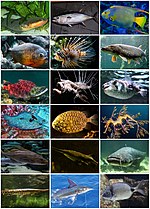Pachycormiformes is an extinct order of marine ray-finned fish known from the Early Jurassic to the end of the Cretaceous. It only includes a single family...
11 KB (828 words) - 10:37, 8 January 2024
Grand & Wilson 2016 Order †Aspidorhynchiformes Bleeker 1859 Order †Pachycormiformes Berg 1937 Infraclass Teleostei Müller 1844 sensu Arratia 2013 Order...
49 KB (3,810 words) - 11:15, 10 November 2024
two diverse Mesozoic fish orders, the Aspidorhynchiformes and the Pachycormiformes. Several other non-teleostomorph teleosteans existed throughout the...
16 KB (1,023 words) - 14:01, 21 August 2024
Leedsichthys (category Pachycormiformes)
would be the largest known teleost — others see them as members of a Pachycormiformes forming the sister group of the Teleostei, and sometimes they are seen...
36 KB (4,510 words) - 21:34, 3 November 2024
Oxford Clay (section Pachycormiformes)
The Oxford Clay (or Oxford Clay Formation) is a Jurassic marine sedimentary rock formation underlying much of southeast England, from as far west as Dorset...
16 KB (834 words) - 04:39, 25 October 2024
During the time of the deposition of the Niobrara Chalk, much life inhabited the seas of the Western Interior Seaway. By this time in the Late Cretaceous...
43 KB (1,746 words) - 18:55, 9 September 2024
as Elopomorpha and Osteoglossoidei appearing during this time. The Pachycormiformes, a group of marine stem-teleosts, first appeared in the Early Jurassic...
234 KB (25,266 words) - 21:16, 9 November 2024
Largest prehistoric animals (section Pachycormiformes)
The largest prehistoric animals include both vertebrate and invertebrate species. Many of them are described below, along with their typical range of size...
390 KB (40,722 words) - 20:46, 11 November 2024
Cretaceous suspension-feeding bony fish Bonnerichthys gladius (Teleostei, Pachycormiformes)". Journal of Vertebrate Paleontology. 33 (1): 35–47. doi:10.1080/02724634...
9 KB (358 words) - 04:03, 15 August 2024
Pachycormus (fish) (category Pachycormiformes)
questioned. Pachycormus has generally been considered basal among Pachycormiformes, with a recent phylogeny finding it to be the second most basal pachycormiform...
5 KB (421 words) - 02:27, 23 October 2024









